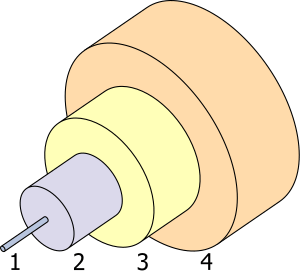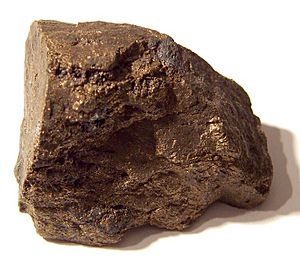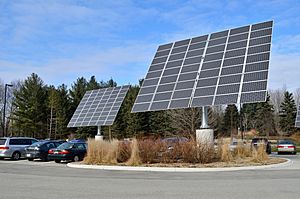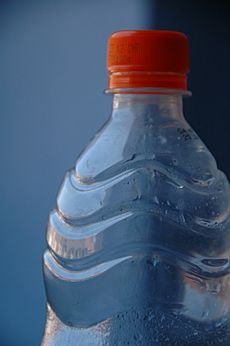Germanium facts for kids
Germanium is a chemical element. Its chemical symbol is Ge. Its atomic number is 32. It was discovered by Clemens Winkler. It is a shiny, hard, silver-white metalloid. The chemistry of Germanium is quite like tin. Germanium forms a large number of organometallic compounds. It is an important semiconductor material used in transistors.
Production
About 118 tonnes of germanium was produced in 2011 worldwide, mostly in China (80 t), Russia (5 t) and United States (3 t). Germanium is recovered as a by-product from sphalerite zinc ores where it is concentrated in amounts as great as 0.3%, especially from low-temperature sediment-hosted, massive Zn–Pb–Cu(–Ba) deposits and carbonate-hosted Zn–Pb deposits. A recent study found that at least 10,000 t of extractable germanium is contained in known zinc reserves, particularly those hosted by Mississippi-Valley type deposits, while at least 112,000 t will be found in coal reserves. In 2007 35% of the demand was met by recycled germanium.
While it is produced mainly from sphalerite, it is also found in silver, lead, and copper ores. Another source of germanium is fly ash of power plants fueled from coal deposits that contain germanium. Russia and China used this as a source for germanium. Russia's deposits are located in the far east of Sakhalin Island, and northeast of Vladivostok. The deposits in China are located mainly in the lignite mines near Lincang, Yunnan; coal is also mined near Xilinhaote, Inner Mongolia.
Applications

1. Core 8 µm
2. Cladding 125 µm
3. Buffer 250 µm
4. Jacket 400 µm
The major end uses for germanium in 2007, worldwide, were estimated to be: 35% for fiber-optics, 30% infrared optics, 15% polymerization catalysts, and 15% electronics and solar electric applications. The remaining 5% went into such uses as phosphors, metallurgy, and chemotherapy.
Optics
The notable properties of germania (GeO2) are its high index of refraction and its low optical dispersion. These make it especially useful for wide-angle camera lenses, microscopy, and the core part of optical fibers. It has replaced titania as the dopant for silica fiber, eliminating the subsequent heat treatment that made the fibers brittle. At the end of 2002, the fiber optics industry consumed 60% of the annual germanium use in the United States, but this is less than 10% of worldwide consumption. GeSbTe is a phase change material used for its optic properties, such as that used in rewritable DVDs.
Because germanium is transparent in the infrared wavelengths, it is an important infrared optical material that can be readily cut and polished into lenses and windows. It is especially used as the front optic in thermal imaging cameras working in the 8 to 14 micron range for passive thermal imaging and for hot-spot detection in military, mobile night vision, and fire fighting applications. It is used in infrared spectroscopes and other optical equipment that require extremely sensitive infrared detectors. It has a very high refractive index (4.0) and must be coated with anti-reflection agents. Particularly, a very hard special antireflection coating of diamond-like carbon (DLC), refractive index 2.0, is a good match and produces a diamond-hard surface that can withstand much environmental abuse.
Electronics
Silicon-germanium alloys are rapidly becoming an important semiconductor material for high-speed integrated circuits. Circuits utilizing the properties of Si-SiGe junctions can be much faster than those using silicon alone. Silicon-germanium is beginning to replace gallium arsenide (GaAs) in wireless communications devices. The SiGe chips, with high-speed properties, can be made with low-cost, well-established production techniques of the silicon chip industry.
Solar panels are a major use of germanium. Germanium is the substrate of the wafers for high-efficiency multijunction photovoltaic cells for space applications. High-brightness LEDs, used for automobile headlights and to backlight LCD screens, are an important application.
Because germanium and gallium arsenide have very similar lattice constants, germanium substrates can be used to make gallium arsenide solar cells. The Mars Exploration Rovers and several satellites use triple junction gallium arsenide on germanium cells.
Germanium-on-insulator substrates are seen as a potential replacement for silicon on miniaturized chips. Other uses in electronics include phosphors in fluorescent lamps and solid-state light-emitting diodes (LEDs). Germanium transistors are still used in some effects pedals by musicians who wish to reproduce the distinctive tonal character of the "fuzz"-tone from the early rock and roll era, most notably the Dallas Arbiter Fuzz Face.
Other uses
Germanium dioxide is also used in catalysts for polymerization in the production of polyethylene terephthalate (PET). The high brilliance of this polyester is especially favored for PET bottles marketed in Japan. In the United States, germanium is not used for polymerization catalysts.
Due to the similarity between silica (SiO2) and germanium dioxide (GeO2), the silica stationary phase in some gas chromatography columns can be replaced by GeO2.
In recent years germanium has seen increasing use in precious metal alloys. In sterling silver alloys, for instance, it reduces firescale, increases tarnish resistance, and improves precipitation hardening. A tarnish-proof silver alloy trademarked Argentium contains 1.2% germanium.
Semiconductor detectors made of single crystal high-purity germanium can precisely identify radiation sources—for example in airport security. Germanium is useful for monochromators for beamlines used in single crystal neutron scattering and synchrotron X-ray diffraction. The reflectivity has advantages over silicon in neutron and high energy X-ray applications. Crystals of high purity germanium are used in detectors for gamma spectroscopy and the search for dark matter. Germanium crystals are also used in X-ray spectrometers for the determination of phosphorus, chlorine and sulfur.
Germanium is emerging as an important material for spintronics and spin-based quantum computing applications. In 2010, researchers demonstrated room temperature spin transport and more recently donor electron spins in germanium has been shown to have very long coherence times.
| Periodic table | |||||||||||||||||||||||||||||||||||||||||
|---|---|---|---|---|---|---|---|---|---|---|---|---|---|---|---|---|---|---|---|---|---|---|---|---|---|---|---|---|---|---|---|---|---|---|---|---|---|---|---|---|---|
| H | He | ||||||||||||||||||||||||||||||||||||||||
| Li | Be | B | C | N | O | F | Ne | ||||||||||||||||||||||||||||||||||
| Na | Mg | Al | Si | P | S | Cl | Ar | ||||||||||||||||||||||||||||||||||
| K | Ca | Sc | Ti | V | Cr | Mn | Fe | Co | Ni | Cu | Zn | Ga | Ge | As | Se | Br | Kr | ||||||||||||||||||||||||
| Rb | Sr | Y | Zr | Nb | Mo | Tc | Ru | Rh | Pd | Ag | Cd | In | Sn | Sb | Te | I | Xe | ||||||||||||||||||||||||
| Cs | Ba | La | Ce | Pr | Nd | Pm | Sm | Eu | Gd | Tb | Dy | Ho | Er | Tm | Yb | Lu | Hf | Ta | W | Re | Os | Ir | Pt | Au | Hg | Tl | Pb | Bi | Po | At | Rn | ||||||||||
| Fr | Ra | Ac | Th | Pa | U | Np | Pu | Am | Cm | Bk | Cf | Es | Fm | Md | No | Lr | Rf | Db | Sg | Bh | Hs | Mt | Ds | Rg | Cn | Uut | Fl | Uup | Lv | Uus | Uuo | ||||||||||
|
|||||||||||||||||||||||||||||||||||||||||
Images for kids
-
Germane is similar to methane.
-
Nucleophilic addition with an organogermanium compound.
See also
 In Spanish: Germanio para niños
In Spanish: Germanio para niños






